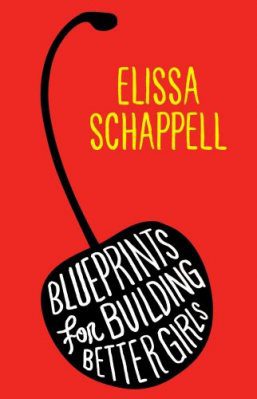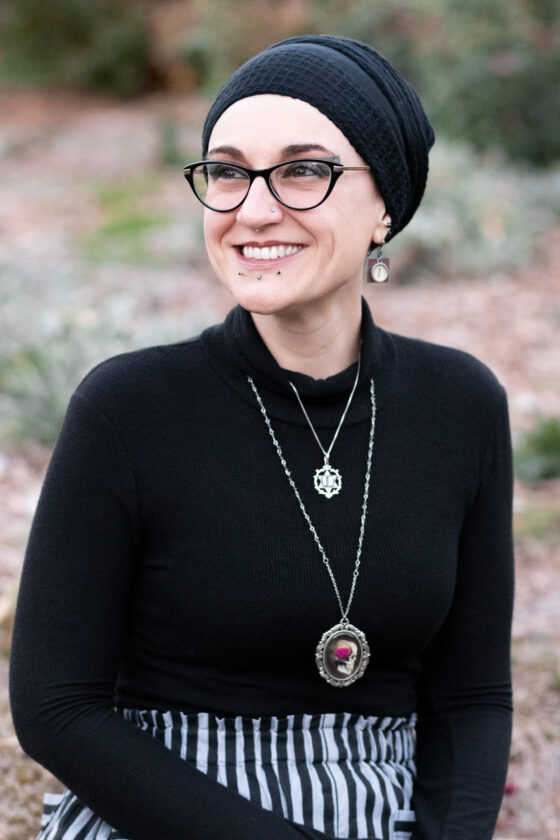Elissa Schappell and I met too many years ago to say, at the Bread Loaf Writers’ Conference. We were both waiters, which means that you serve students, scholars, fellows and faculty, and you either watch people behave badly or you behave badly with them. Even on little sleep and instant mashed potatoes, Elissa enthralled us with her wit, her ferocity, her cleverness and her sophisticated sense of style.
Elissa is one of the few writers I know who is entirely herself—in all those multiple incarnations—on the page. Not because her work is autobiographical, per say, but because her fiction, which is fierce, wild, hilarious and passionate, encompasses many aspects of her personality. When, Use Me, a collection of linked stories, was published in 2000, it was a finalist for the Pen/Hemingway award. Now, ten years later, her second book, Blueprints for Building Better Girls takes the wide-ranging themes that make up women’s lives and grows them into distinctive and brave connected stories, with the kinds of characters we both want to live up to, and live down.
Elissa is also an admirable literary citizen. She is a contributing editor at Vanity Fair, where she the author of the “Hot-Type” column. She has been a Senior Editor at the Paris Review and is a founding editor of the literary magazine, Tin House. Elissa has also been the co-editor of the anthologies, The Friend Who Got Away and Money Changes Everything. She lives in Brooklyn, New York with her family and too many hats to count.
***
The Rumpus: Blueprints for Building Better Girls chronicles, in many ways, the perils of growing up female. Can you discuss taking on this litany of female “problems,” like anorexia, rape, miscarriage, “sluttiness”?
Elissa Schappell: The truth is, I didn’t start out with a plan to take on anything, save for the voices in my head, and all these ideas I was formulating about what it means to be a girl or woman in America today. It wasn’t until I’d written a few stories that I noticed what I was doing was creating these archetypal female characters—the slut, the good girl, the bad mother, the party girl, all these women we think we know—and making them complicated human beings. Subverting the reader’s expectations of who they were. Who the culture says they are, or should be.
In this way the book really is a handbook. These “perils” are the sort that etiquette books exist to address, as in: What is proper decorum for a well-bred young lady whose been raped? Dos and don’ts for making new friends with fellow mommies. Do: Take wine to the playground in a thermos. Don’t: Threaten to smack your child’s face off. You know, what the culture dictates what women should do versus what they actually do. Good girls don’t do body shots.
The “taking on” part came in the revising, once I knew what the story was.
Rumpus: Instead of archetype, we could use the word label. Your book takes place—and in this way it is novelistic in its scope—from the seventies until the present. Do you think these labels have changed over the past forty years?
Schappell: Obviously there’s been some change, right? I don’t think the labels have changed so much as the behaviors associated with them, which is a thread that runs throughout the book. What it means to be a good wife now, versus thirty years ago is pretty different given the realities of modern marriage. Save for stuff like, Don’t have sex with the gardener, and Mrs. Dale Carnegie’s, “Laugh when your husband’s boss makes a joke, but not too much!”
However, the label “slut” hasn’t changed much, or how you get it. “Slut” has always been the sharpest chisel in the bullies’ toolbox of ways to dismantle a women. It has little relation to how much sex a girl is having. We all know that just as many “good girls” are screwing in the back of their boyfriends’ cars as “sluts” and fewer of them use protection. In the case of the heroine in Monsters of the Deep, she’s just a girl who got breasts before her peers, is comfortable with her body and her sexuality. She’s a mystery to them and her power is unsettling, thus they project all their sexual frustration and aggression on to her.
Rumpus: This book deals very much with being a parent, a mother. What do you think is unique about that character in fiction? Do you think mothers become invisible as characters? Does that reflect how they’re seen—or not seen—in the world?
Schappell: Actually only three of the eight stories are about being a parent—what all of the stories share, and I think this is what you’re picking up on, is that in every story you are aware of how the main character’s relationship with her mother has made her into the girl or woman she is. In this are the echoes of how the culture dictates what is acceptable and unacceptable behavior, in this case for an upper-middle class white woman in our modern time.
What is what is so unique about the mother in fiction is the power mothers possess. It’s scary. We have the power to give you life, and if we choose, buckle you into your car seat and drive the family station wagon off a dock. You know, fathers can leave, but mothers stay. What I wanted to show in the stories was that not all mothers are happily self-sacrificing, not all love their children as much or more than their husbands, and not all mothers are to blame for their children’s problems, in the case of one of the stories told from the point of view of the mother—not to blame for their daughters’ eating disorders.
In terms of the mother in literature what we see, historically—and I’m generalizing here—is a disconnect between the multi-faceted, complicated human beings mothers are, and the way they’re often portrayed. They’re Medea or Mildred Pierce, or a stereotype—the meddling Jewish mother like Sophie Portnoy, or the cold withholding WASP in any number of Cheever stories.
I don’t think mothers are invisible so much as their power is invisible. Like the term soccer mom. Who in the fuck is the soccer mom? She’s a sexless, jobless woman behind the wheel of an SUV, carting around a bunch of ten-year-olds. Or, perhaps she volunteers at a rape crisis shelter, is banging her contractor, and she’s using the kids as drug mules. We seem to assume—and I was as guilty of this as anyone—that men have richer lives simply because they leave the house, and punch a time card.
Rumpus: Do you think men read your books?
Schappell: Sure. However, with Use Me, the majority of men who approached me about the book told me, “Oh! I just bought your book for my wife.” “Or, my girlfriend loves your writing.” The first few times I just smiled politely, then I started saying, “Don’t worry. You can read it. There aren’t that many big words in it. Read it with a dictionary.”
It seems like men are reading this book. Or, every man who has read it has decided write me. Which is lovely. Perhaps it’s because reviewers—and these are good reviews, some written by women—keep writing about how “provocative” and “darkly funny” they are (which perhaps can be construed as naughty and mean?) as well as “full of unsympathetic female characters,” who are inevitably cited as being unstable, depressed, dangerous… In my experience men are mad for female characters who are liable to pop off without warning.
Perhaps it’s the title? Maybe they assume the book contains actual plans for how to build your own horny nubile robot? No, it’s because it’s been proven that women seeing a man reading my book immediately assume, He must be incredibly smart and great in bed.
Seriously, though, this is all about conflating gender with genre. It’s bullshit. I’ve examined books by Hemingway and Austen with a high powered microscope and failed to find evidence of any genitalia, male or female on either.
Rumpus: Something you said to me years ago has stayed with me. You said, writing like a man would be the biggest compliment. Do you still think that? Why?
Schappell: I’ve always wanted to be taken as seriously as my male counterparts. I didn’t mean I wanted to be a male writer. (Although I could do with an art wife.) I suppose what I was saying was I felt that the only time gender doesn’t figure into evaluating the worth of a piece of art, is when the artist is a man. That’s the baseline for comparison. As good as, worse than, better than, comparison to men. So I would prefer to have my gender be invisible. Although given that we’re talking you and me—years ago…was I on top of a table, shaking my fist? I might have been in the bag. Regardless, that sentiment is pretty funny when you consider the feminist slant of this book.
Rumpus: The stories of these characters lives are passed on, often to surprising people. What is it about re-ordering our stories, re-telling it for our children or friends, that changes it?
Schappell: We need to tell our stories. It’s a form of currency, catharsis, it’s how we frame our experiences. It allows us to create and take control of our identity, right? Because the stories are told from different points of view, and the way characters sometimes overlap we see how these women reframe experiences, reimagine themselves—as the hero, villain, innocent bystander.
Rumpus: This makes me think of audience, how as readers we are either being told a story or eavesdropping on a story. Your characters do both—they talk to the reader directly, and they let the reader spy women talking to each other, to their partners, children.
Schappell: I wanted the reader to see characters from several different perspectives. I wanted Bender, the party girl, to have an opportunity to talk directly to the reader, to have her say, because no one listens to her. In the case of Charlotte, the young woman whose been raped, I wanted to keep the reader at distance. To protect her. You don’t get to be in her head. There’s only one person she feels she can tell that story to.
Rumpus: Can we talk about humor? Because, you are a funny lady, on and off the page. How are you using humor to come at these difficult subjects?
Schappell: You have to make them laugh, or I do, because as Oscar Wilde said, “If you want to tell people the truth, make them laugh, otherwise they’ll kill you.” I simply can’t run that fast.
Rumpus: As a writer, you are using it as a cloak too, right?
Schappell: My characters use humor to protect themselves, make people like them, to diffuse awkward situations. Like everyone they are whistling past the graveyard, difference is as they’re whistling they’re checking out the inscriptions on the graves, (Mother She Made Home Pleasant) and wondering if it’s possible for fake flowers to ever make a grave look cheerier, and not sadder.
The fact is if you make people laugh, they are less likely to shut you inside a locker. They will invite you to lunch. When you open your mouth, they will stop talking and, expecting to be entertained, quiet. Listen. Let their guard down. You disarm them with a few bad puns. Then, once you’ve got them laughing, they trust you, you can slip your knife into their side, they don’t even notice until they start to feel the ache.
Rumpus: Humor is very subjective. There’s nothing more particular than humor, is there?
Schappell: You’re right. Some people get the humor in the stories, others don’t. There will always be those who say, “You shouldn’t be making jokes about cancer or miscarriage or abortion. It’s not funny. You’ve crossed the line.” If that’s not enough, they’ll add, “Not only that, you seem angry.” Well, I am angry, and as to these rules the culture imposes on women, on me, I wasn’t there when we voted. So, if you’ll pardon me sir, madam, you can stick it.






